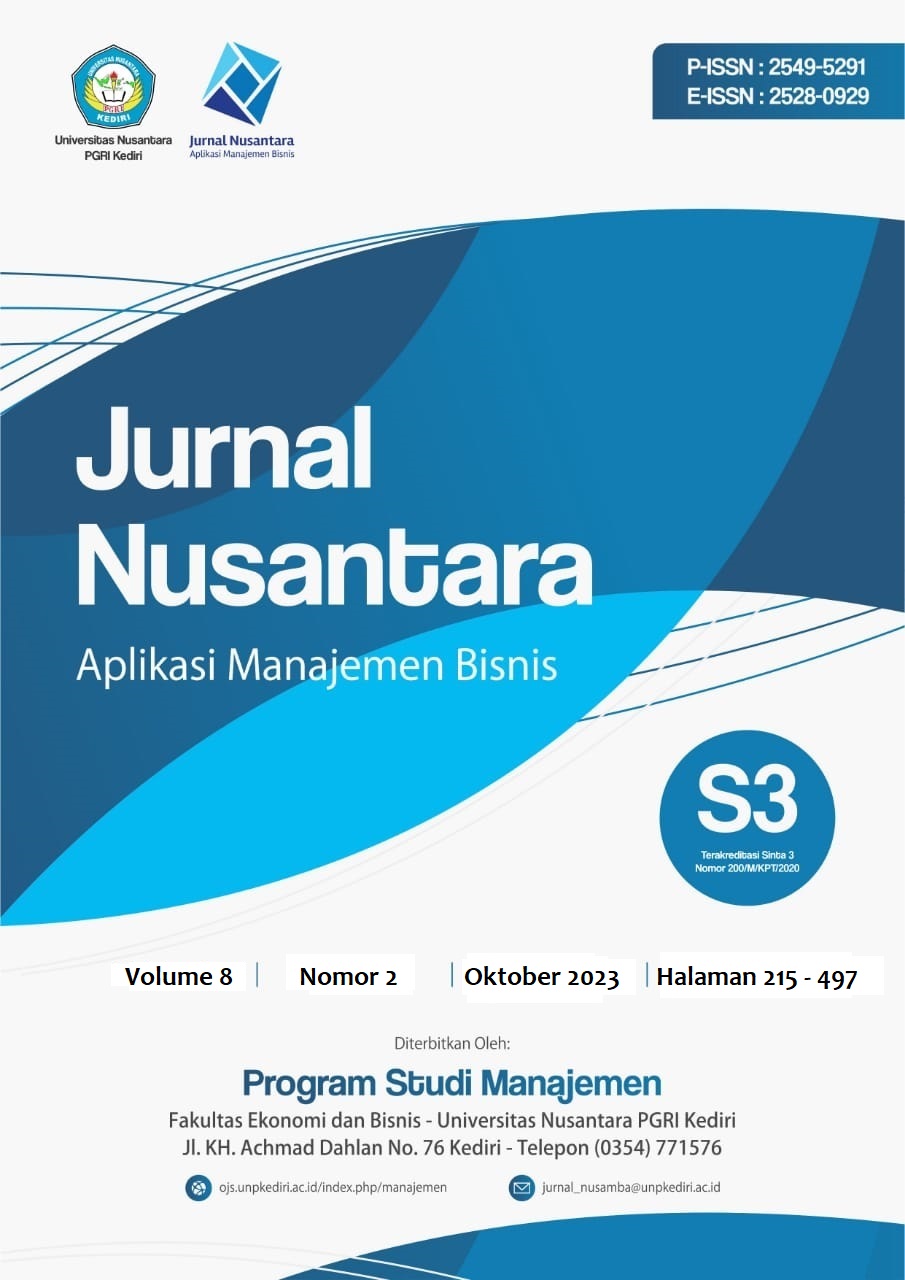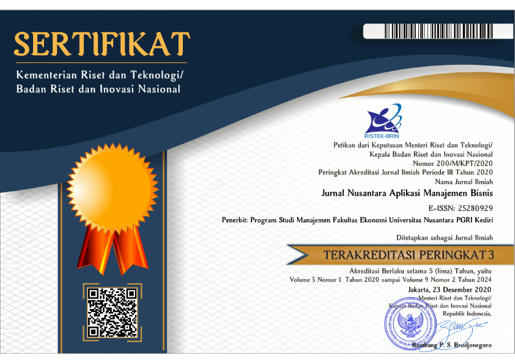Penggunaan Media Pemasaran Pada Mahasiswa Perguruan Tinggi Terbuka dan Jarak Jauh Di Indonesia
DOI:
https://doi.org/10.29407/nusamba.v8i2.19518Keywords:
marketing media, open and distance students, demographic, cross-tabulationAbstract
Research aim: This study aimed to determine the preferences of marketing media used by UT students according to demographic characteristics.
Design/Methode/Approach: This study uses a quantitative approach with survey methods through convenience sampling with non-probability techniques. This study distributed the questionnaire link and obtained respondents from as many as 6.155 UT students in Indonesia and abroad. The results of this study are the marketing media used by UT students based on demographic characteristics, namely age, gender, region of origin, and occupation using cross-tabulation analysis.
Research Finding: The formulation of the research problem is how the demographic characteristics and cross-tabulation of the use of marketing media used by UT students.
Theoretical contribution/Originality: In addition, the various choices of communication media encourage audiences to use communication media to meet their needs. Before determining this strategy, UT needs to know the marketing media used by students when they search for and obtain information about the open and distance higher education system.
Practitionel/Policy implication: The implication of this research is the first step in making marketing and promotion strategies and knowing the effective and efficient use of marketing media.
Research limitation:
Students at Universitas Terbuka have different characteristics from those at other institutions, which can be seen in demography, geography, psychography, and behavior. To increase the Gross Enrollment Rate for Higher Education, UT has a target of one million students in 2024, so a planned, effective, and efficient marketing and promotion strategy is needed, as well as on target.
Downloads
References
Tam CM WJ. Designing and evaluating e-learning in higher education: a review and recommendations. J Leadersh Organ Stud. 2005;11(2):15–25. https://doi.org/10.1177/107179190501100203
Carvalho SW de OMM. The role of trust in creating value and student loyalty in relational exchanges between higher education institutions and their students. J Mark High Educ. 2010;20(1):145–65. https://doi.org/10.1080/08841241003788201
DeShields OW Jr, Kara A KE. Determinants of business student satisfaction and retention in higher education: applying Herzberg’s two-factor theory. Int J Educ Manag. 2005;19(2):128–139. https://doi.org/10.1108/09513540510582426
Nasution L. Strategi Dalam Menghadapi Persaingan Perguruan Tinggi di Propinsi Sumatera Utara Melalui Analisis SWOT (Studi Kasus UMN Al Washliyah Medan). J Konsep Bisnis dan Manajemen, Univ Medan Area. 2018. https://doi.org/10.31289/jkbm.v5i1.1745
Mirandani KR, Fitria SE. Analisis Preferensi Konsumen Terhadap Strategi Komunikasi Pemasaran (Studi Pada Toko Pakaian Batik Di Pasar Mayestik Jakarta Selatan). e-proceeding Manag. 2019;6(2):2162–9. https://openlibrarypublications.telkomuniversity.ac.id/index.php/management/article/view/9568/9438
Ary M. Menentukan Prioritas Pilihan Mahasiswa Dalam Memilih Kampus Menggunakan Analisis Conjoint. Informatika. 2015;II(2):376–84. https://doi.org/10.31294/ji.v2i2.113
Lupiyoadi R. Manajemen Pemasaran Jasa. Jakarta: Salemba empat; 2001.
Cangara H. Perencanaan & Strategi Komunikasi. Jakarta: PT Raja Grafindo Persada; 2014.
Tjiptono F. Pemasaran Esensi dan Aplikasi. Yogyakarta: ANDI; 2016.
Anugraheni DT dan VK. Preferensi Konsumen terhadap Media Sosial dalam Mencari dan Membeli Produk secara Online. J Ekon dan Bisnis. 2018;21(2). http://dx.doi.org/10.31941/jebi.v21i2.780
Neuman WL. Social Research Methods Qualitative and Quantitative Approaches. 4th Edition. Boston: Allyn and Bacon; 2000.
N. K. Malhotra, D. Nunan dan DFB. Marketing Research: An Applied Approach. London: Pearson Education Limited; 2017.
Kotler P dan KKL. Manajemen Pemasaran, Edisi Tiga belas, Jilid Dua. Jakarta: Erlangga; 2009.
Sinaga, Bona Aripin D. Pengaruh Electronic Word Of Mouth dan Promosi Media Sosial Terhadap Minat Beli pada Produk Fashion Eiger. 2020; https://doi.org/10.37641/jimkes.v8i2.329
Annur CM. Tujuan Responden dalam Menonton TV [Internet]. 2022. Available from: https://databoks.katadata.co.id/datapublish/2022/04/26/survei-mayoritas-penonton-tv-suka-sinetron-dan-acara-olahraga
Hastuti RP. Pengaruh Terpaan Iklan Shopee di Televisi Terhadap Minat Beli Masyarakat Desa Jenggrik Kedunggalar Ngawi [Internet]. IAIN Ponogoro; 2022. Available from: http://etheses.iainponorogo.ac.id/18257/1/Risma Skripsi.pdf
Ribek, Pande Ketut D. Pengaruh Iklan televisi dan Online Customer Review Terhadap Keputusan Pembelian pada MarketPlace Shopee di Bali. J Satyagraha [Internet]. 2022;5(2). Available from: http://ejournal.universitasmahendradatta.ac.id/index.php/satyagraha
Ramnarain. Youth Social Media Browsing and Consumer Behaviour. J Bus Econ Manag. 2013; DOI: 10.5897/AJBM12.1195
Sudarmono LH. Analisis Peningkatan Keputusan Pembelian Melalui Faktor-Faktor yang Membentuk Preferensi Merek Coffee Shop di Social Media. Universitas Diponegoro; 2016. http://eprints.undip.ac.id/49801/
Kotler P dkk. Marketing 4.0 Bergerak Dari Tradisional Ke Digital. Jakarta: PT Gramedia Pustaka Utama; 2021.
Nurfatwa A, Mbti PS, Ekonomi F, Telkom U. Analisis Preferensi Media Promosi Universitas Telkom Berdasarkan Segmentasi Aktivitas Media Sosial ( Studi Kasus pada Peserta SMB UTG – 1 2015 Universitas Telkom ) Analysis Of Telkom University ` S Promotion Media Preferences Based On Social Media Activity. 2015;2(2):1450–4. https://openlibrarypublications.telkomuniversity.ac.id/index.php/management/article/view/167/155
Downloads
Published
Issue
Section
License
Authors who publish with this journal agree to the following terms:
- Copyright on any article is retained by the author(s).
- The author grants the journal, the right of first publication with the work simultaneously licensed under a Creative Commons Attribution License that allows others to share the work with an acknowledgment of the work’s authorship and initial publication in this journal.
- Authors are able to enter into separate, additional contractual arrangements for the non-exclusive distribution of the journal’s published version of the work (e.g., post it to an institutional repository or publish it in a book), with an acknowledgment of its initial publication in this journal.
- Authors are permitted and encouraged to post their work online (e.g., in institutional repositories or on their website) prior to and during the submission process, as it can lead to productive exchanges, as well as earlier and greater citation of published work.
- The article and any associated published material is distributed under the Creative Commons Attribution-ShareAlike 4.0 International License












